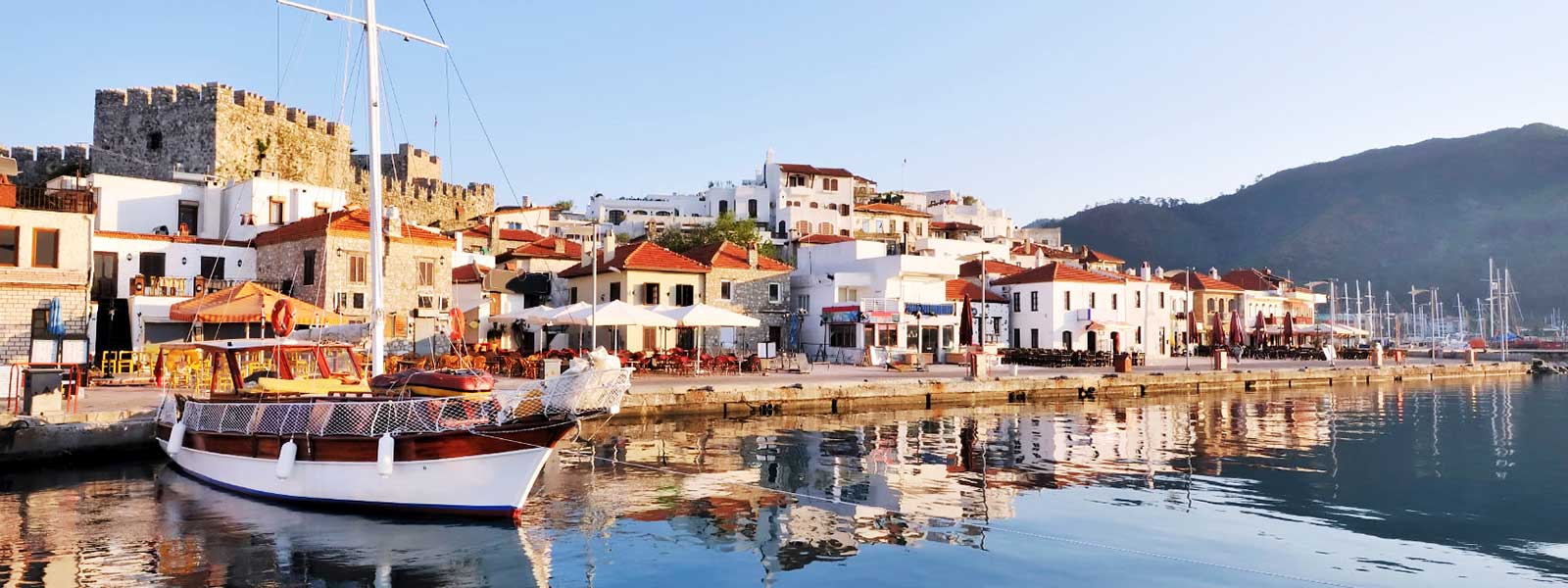
MARMARIS
Another festive ‘frolic’ destination in Turkey that comes second after Bodrum; Marmaris has a resemblance of an old town on a hill overlooking the harbor. Good chill out & fun place with around about 2000 shops which endlessly repeat themselves: the jewelry workshops, the leather goods, carpet dealers, tea & herbs & spices shop and the leather shops again and again… and is one of the most popular ports for blue cruise & yachting; just like Kusadasi port which welcomes many cruise ships every year, too.
The road southwards from Mugla to Marmaris rises to the mountain pass of Sakar at a thousand meters, and from there begins to wind its way down. The views from here are spectacularly beautiful. Far below is a broad fertile plain stretching all the way to Dalaman, through whose orchards the Marmaris road runs beneath the shade of eucalyptus trees to the shores of the Aegean.
The name of this plain is Gokova, Plain of the Sky. When you catch sight of Gokova and its picturesque small port of Akyaka from your vantage point on the mountainside, it is impossible not to be astonished. 'The sea suddenly appearing behind a hill is lovelier than all dreams of paradise, more astounding than any new inventions,' says Sabahattin Eyuboglu, and adds, 'If you are not surprised every time you see the sea, the world, and people, then do not bother to read poetry. You will never understand it.'
The Gulf of Gokova is a narrow tapering fjord, more than 80 kilometers in length and 35 kilometers wide at the mouth, lying between the Bodrum and Resadiye peninsulas. Although from a distance the gulf appears as calm as a mirror, this appearance is deceptive, and strong winds off the open sea can put seamen through their paces here. It is this gulf, with its myriad inlets, coves and bays, and beautiful wooded shores, which is the principal destination for the famous Blue Cruises.
The Gulf of Gokova has two other names. On foreign maps, particularly British ones, it is often called the Gulf of Kos, and by locals is known as the Gulf of Kerme, after the ancient city of Keramos in the vicinity of Oren. There is another ancient city of the same name near Athens, both so named because they were major centers of ceramic production, although at our Keramos no trace has so far been found of any pottery at all.
Those who set sail from Bodrum to the Gulf of Gokova follow the coast in a southeasterly direction to Tavsan headland and then pass Yaliciftligi, Orak islands, and the bays of Kargi, Cokertme, Cakal, and Akbuk. East of Kerme headland the Kiran Mountains plunges down to the sea from a height of nearly one thousand meters. Around Akyaka the sea is shallow, and the yachts have to keep their distance from the shore. Akyaka was originally a tiny fishing village boasting only a Forestry Department camping site and picnic area, but it has slowly grown since the 1970s into a popular resort. The history of the Akyaka and Gokova region goes back to 2600 BC. The Carian city of Idyma was the earliest settlement here, and the rock tombs at Kozlukuyu and Inisdibi date from this period. The city's acropolis lies 250-300 meters above the rock tombs. During the Hellenistic period, which began with the conquest of Anatolia by Alexander the Great, the city became known as Rhodesian, meaning 'opposite Rhodes', and that island ruled the area from around 200 BC until it became part of the Roman Empire at the end of the 1st century.
Epidemics and earthquakes from the 3rd century onwards struck the city a blow from which it never recovered, and Idyma was buried in the pages of history. The Turks first arrived in Gokova in the 13th century during the time of the Mentese Principality, and the area became part of the Ottoman Empire in 1420.
The streams of Akcapinar and Kadin which flow into the gulf at Akyaka provide cool retreats during the hot summer months. There are small fish restaurants on the banks of the Kadin, which is home to otters. Gokova marsh south of Akyaka is visited by many migrating birds, including flamingos and pelicans, and in 1988 an environmental conservation programme was launched at Akyaka.
As well as the abundant wildlife, Akyaka is famous for its traditional whitewashed houses, and the town's architectural fame was further enhanced by the house of Nail Cakirhan which won the Agha Khan Prize for Architecture. Akyaka is 29 kilometers from Mugla, and 32 kilometers from Marmaris.
The sun shines for 270 days of the year, and the sea is warm enough for swimming for seven months. In the year 2000, the shore here was awarded a Blue Flag. With its magnificent scenery, fascinating flora and fauna both on land and underwater and historic sites, Gokova is indeed a place of dreams.
At Travel Atelier, we provide shore excursions to cruise ship passengers. Contact us now to book your private tours.
